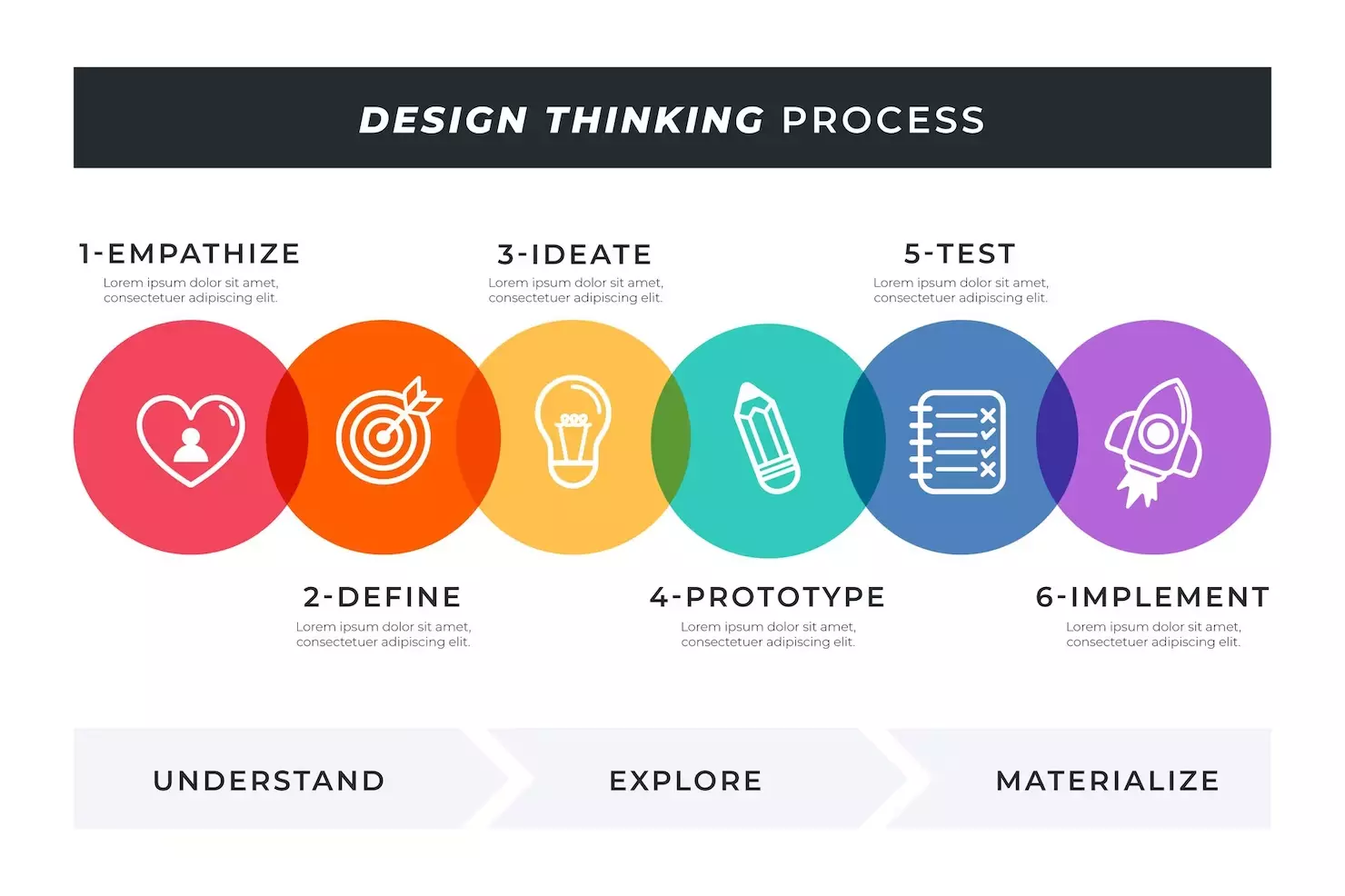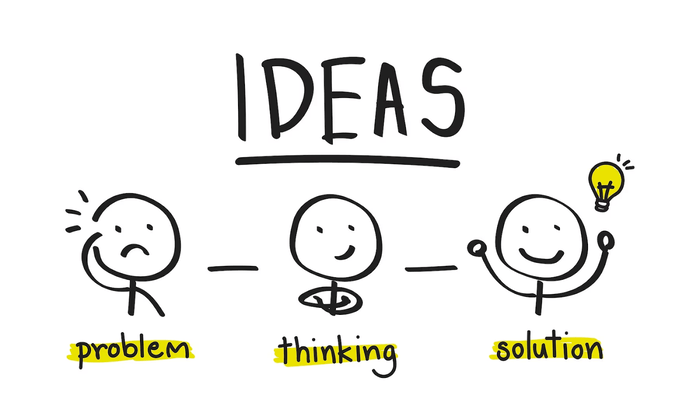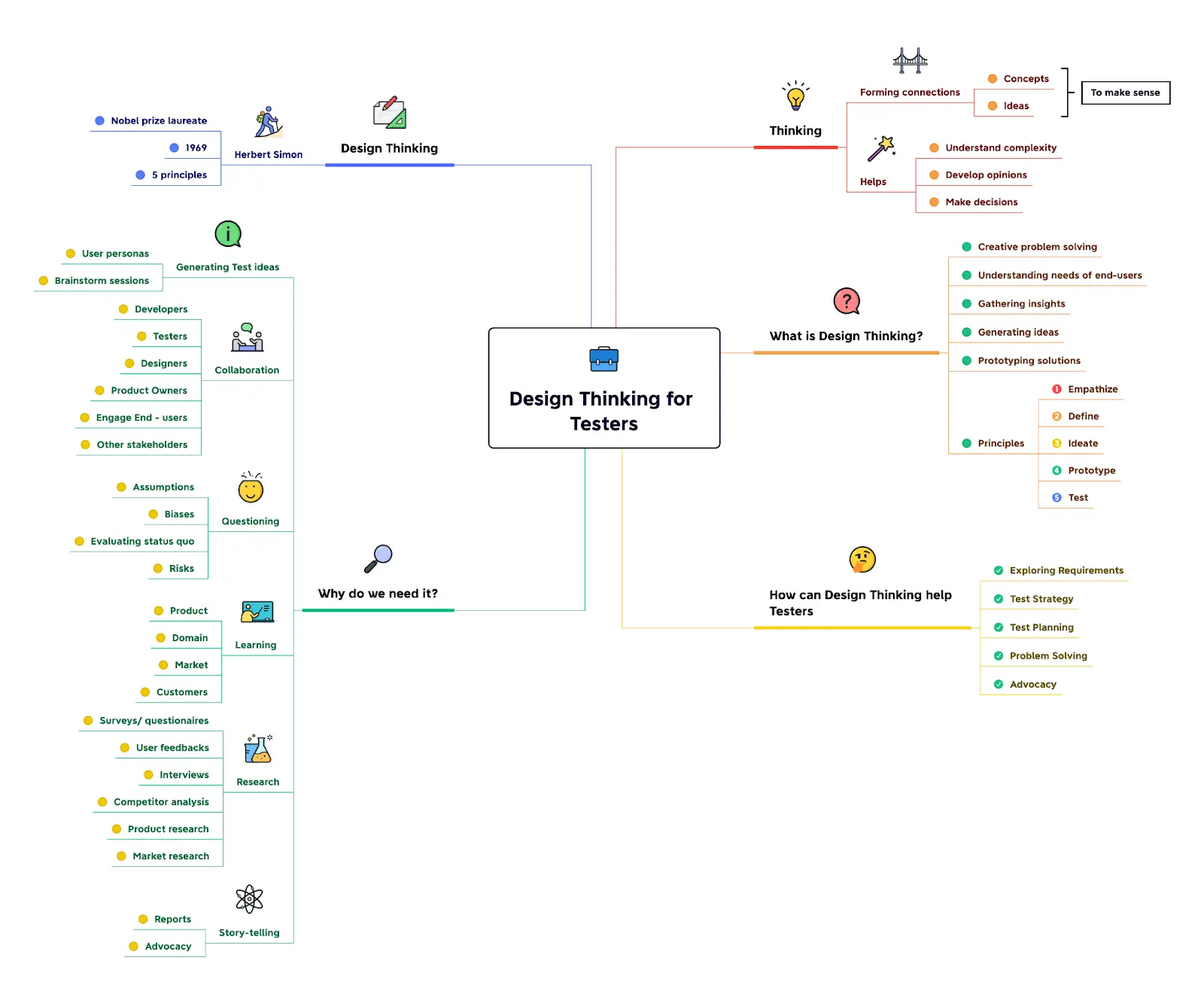Design Thinking for Testers

We quite often hear about Design thinking in our industry, but how well do we understand it? As Testers, how does it help us? Throughout this article, we will explore Design thinking and how it can benefit testers.
To understand Design thinking, let’s first understand Thinking.
The act of thinking is an essential part of human existence. In order to make sense of the world around us, we form connections between concepts and ideas. In addition, it aids us in understanding complex situations, forming thoughtful opinions, and making informed decisions.
Design thinking, Systems thinking, and Critical thinking are all types of thinking that can be useful in our work and daily lives. System thinking emphasizes understanding how a whole system works, whereas design thinking considers problem solutions through innovative design. Critical thinking is the ability to evaluate information objectively before making decisions based on it.
Now that we understand what thinking is, let’s delve deep to understand Design thinking.
Here's everything you need to know about Salesforce Sales Cloud.
What is Design Thinking?
Design thinking is a creative problem-solving approach that involves understanding the needs of end users, gathering insights, generating ideas, prototyping solutions, and testing them to arrive at a desirable and feasible result.
For testers, it is a powerful technique, useful for Automation development and Test Design.
Principles of Design Thinking

1. Empathize
Empathy is the ability to understand and share the feelings of others. By considering end users' perspectives when designing and testing a product or service, we take the time to understand their needs, wants, and experiences.
2. Define
This stage is about defining the problem that needs to be solved. Through empathy, we learn about the problem and narrow down our perspectives to define the problem in a way that is manageable and solvable.
3. Ideate
This stage involves generating and evaluating ideas. Brainstorming sessions or other techniques can be used to come up with a variety of potential solutions. Considering a variety of ideas and approaching ideation with an open and curious mindset can lead to more innovative and creative solutions.
4. Prototype
Prototyping ideas is the next step in testing and refining them once they have been generated. A prototype can be a simple sketch or model of a solution, or it can be a fully-functional prototype that can be tested with users. In prototyping, we can learn how a solution might work in practice, as well as identify any issues or challenges before developing the final product.
5. Test
This stage involves conducting usability testing, where users are asked to perform specific tasks with a product or service to identify any problems or areas for improvement. Testing can also involve gathering feedback from users on their overall experience with a product or service and using this feedback to make refinements and improvements.

How can Design Thinking help Testers?
Design Thinking combines creative and analytical thinking to help testers identify the root cause of problems and come up with creative solutions. It also helps them think outside of the box to come up with new ideas and approaches to testing.
Design thinking encourages us to think creatively and systematically about identifying and addressing problems. It motivates us to brainstorm ideas which in turn expands our knowledge about the product.
Let’s look at some of the areas of software testing and how design thinking can help us.
Exploring requirements:
The design approach lets us come out of our biases and question our assumptions. By applying one of the key aspects of design thinking - Empathy, testers can study the needs and feelings of the users for the product/service and identify the product gaps in the requirement stage itself.
Test Strategy:
By empathizing with the end-users, we understand their needs and desires better. Through the ideation aspect of the Design framework, we tend to brainstorm ideas. The amalgamation of these two aspects, empathy, and ideation, makes us better at building our test strategies. Putting our left and right brain equally in this process we can build more detail-oriented, imaginative, and logical test strategies.
Test Planning:
With a concrete test strategy backed by ideas, innovation, and creativity, rooted around user needs, we can do better test planning in collaboration with all the stakeholders. A design thinking mindset with divergent and convergent aspects helps us to understand the product and evaluate the risks, helping us to plan our testing well.
Problem-solving:
Be it a problem of the product, process, or people, the design thinking approach is open to curiosity and questioning. It helps us to learn about the problem in detail and directs us to a solution by seeking answers to the questions.
Advocacy:
As we empathize and understand the user’s needs better, we can become better advocates for their needs and desirabilities.

Why do Testers need Design Thinking?
It pulls us out of our own experiences and biases, opening us to new ways of thinking and shining a light on new perspectives. As testers, we need to understand the end user’s needs and desirability so that we can aid the development in the right direction. Following are a few of the areas where this design mindset is needed for us to become better at software testing :
1. Generating Ideas:
Whenever we test a product, we need to generate creative test ideas to test the product. The design thinking approach encourages us to think creatively and systematically. Test ideas on the lines of different user personas, demographics, FTUE, etc. are some examples.
2. Collaboration:
Design Thinking encourages collaboration between testers, developers, designers, and other stakeholders to ensure that all perspectives are considered when developing a solution. Engaging the end-users by taking their feedback and suggestions, inculcating them, and advocating for them helps us build good relationships between the product and its users.
3. Questioning:
Brainstorming for ideas generates questions as one of the byproducts. As we question the biases, assumptions, user needs, and desires, we tend to deepen our knowledge about the product. Questioning the status quo at every step keeps us on our toes and helps us identify risks early.
4. Learning:
One important aspect of testing in the context of design thinking is to approach it with a learning mindset. Learning about the product, market, etc., deepens our domain knowledge. This means viewing testing as an opportunity to gather insights and gather feedback rather than simply looking for things that are wrong or don't work. By adopting this mindset, testers can help to create a culture of continuous learning and improvement within their teams and organization as well.
5. Research:
Developing a product and testing a product go hand in hand. Feedback from testers helps the developers to build the product in the right direction. Product and market research through surveys, questionnaires, interviews, competitor analysis, market analysis, etc., are critical for us to understand the product's viability. The design thinking approach helps broaden the spectrum and makes us better researchers.
6. Story-telling:
As testers, it is all the more important for us to learn and practice the art of storytelling. We need to weave all our research, data, and analysis and present it to the stakeholders in an appealing way. Empathy maps, user journeys, feedback, reviews, etc., can all be used to advocate for the user’s needs

In summary, design thinking is a valuable approach for testers, as it encourages us to think creatively and systematically about identifying and addressing problems in a product or service. In addition, understanding the core principles and applying them to our context helps us to test better and establish credibility in the industry. So, design thinking is an essential skill for testers to have in today's fast-paced, rapidly changing world.
Related Posts
 What Is Oracle Test Automation
What Is Oracle Test Automation
What Is Oracle Test Automation
 Making Software Delivery More Resilient and Agile with Salesforce CI/CD
Making Software Delivery More Resilient and Agile with Salesforce CI/CD



































